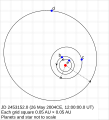Файл:GJ581orbits.svg

Размер этого PNG-превью для исходного SVG-файла: 545 × 600 пкс. Другие разрешения: 218 × 240 пкс | 436 × 480 пкс | 698 × 768 пкс | 931 × 1024 пкс | 1862 × 2048 пкс | 660 × 726 пкс.
Исходный файл (SVG-файл, номинально 660 × 726 пкс, размер файла: 6 КБ)
История файла
Нажмите на дату/время, чтобы посмотреть файл, который был загружен в тот момент.
| Дата/время | Миниатюра | Размеры | Участник | Примечание | |
|---|---|---|---|---|---|
| текущий | 15:13, 6 ноября 2010 |  | 660 × 726 (6 КБ) | Icalanise | Added direction arrows and data |
| 21:43, 12 октября 2010 |  | 640 × 768 (5 КБ) | Icalanise | Reverted to version as of 21:29, 17 June 2009: existence of planets f and g is controversial | |
| 23:06, 30 сентября 2010 |  | 640 × 768 (3 КБ) | Icalanise | Update to 6-planet circular orbit solution. The orbit of planet f is too large to appear on this scale. | |
| 05:16, 30 сентября 2010 |  | 640 × 768 (5 КБ) | Tomruen | Add planet g as circular orbit, 0.14 AU | |
| 21:29, 17 июня 2009 |  | 640 × 768 (5 КБ) | Icalanise | Added orbit of planet "e" and revised orbit of "d" | |
| 14:11, 30 октября 2008 |  | 640 × 640 (5 КБ) | Icalanise | Hide grid behind info text | |
| 14:08, 5 октября 2008 |  | 640 × 640 (5 КБ) | Icalanise | fix font size bug | |
| 13:43, 5 октября 2008 |  | 640 × 640 (5 КБ) | Icalanise | {{Information |Description={{en|1=SVG image of the Gliese 581 system. The orbital parameters are taken from Udry et al. (2007), A&A 469, L43-L47 "The HARPS search for southern extra-solar planets XI. Super-Earths (5 and 8 M_⊕) in a 3-planet system" and |
Использование файла
Следующая страница использует этот файл:
Глобальное использование файла
Данный файл используется в следующих вики:
- Использование в ar.wiki.x.io
- Использование в be-tarask.wiki.x.io
- Использование в cs.wiki.x.io
- Использование в cs.wikinews.org
- Использование в da.wiki.x.io
- Использование в el.wiki.x.io
- Использование в en.wiki.x.io
- Использование в eo.wiki.x.io
- Использование в fi.wiki.x.io
- Использование в fr.wiki.x.io
- Использование в hr.wiki.x.io
- Использование в ja.wiki.x.io
- Использование в ko.wiki.x.io
- Использование в nl.wiki.x.io
- Использование в si.wiki.x.io
- Использование в vi.wiki.x.io
- Использование в zh.wiki.x.io
- Использование в zh.wikinews.org
